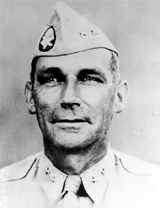William C. Lee
| William C. Lee | |
|---|---|
 | |
| Nickname(s) | "Father of the U.S. Army Airborne" |
| Born |
March 12, 1895 Dunn, North Carolina, United States |
| Died |
June 25, 1948 (aged 53) Dunn, North Carolina, United States |
| Allegiance |
|
| Service/branch |
|
| Years of service | 1917–1944 |
| Rank |
|
| Unit |
|
| Commands held | 101st Airborne Division |
| Battles/wars |
World War I World War II |
| Awards |
Distinguished Service Medal Parachutist Badge Army of Occupation of Germany Medal World War I Victory Medal World War II Victory Medal |
Major General William Carey "Bill" Lee (March 12, 1895 –June 25, 1948) was a senior United States Army officer who fought in both World War I and World War II, where he commanded the 101st Airborne Division, nicknamed the "Screaming Eagles". Lee is often referred to as the "Father of the U.S. Airborne".[1]
Early life and military career
Lee was born in Dunn, North Carolina, one of the seven children of Eldridge Lee and his wife Emma. His father was a merchant.[2] He attended Wake Forest College and North Carolina State College. He participated in the Reserve Officer Training Corps (ROTC) program, graduated from NC State, being commissioned as a second lieutenant in the Infantry Branch of the U.S. Army in 1917. Lee served in World War I with the American Expeditionary Force (AEF), commanded by General John J. Pershing, on the Western Front.
By the time the United States entered World War II, in December 1941, Lee had reached the rank of major general and was a proponent of airborne warfare. President Franklin Roosevelt sponsored the concept, and Lee was authorized to form the first paratroop platoon. This was followed by the Provisional Parachute Group, and finally the U.S. Army Airborne Command. Lee was the first commander of the U.S. Army's jump school at Fort Benning, Georgia. He received the Distinguished Service Medal for his early leadership in the creation of the airborne forces.
In August 1942, Lee became Commanding General (CG) of the newly formed 101st "Screaming Eagles" Airborne Division, based at Camp Claiborne, Louisiana. He told his men, "The 101st has no history, but it has a rendezvous with destiny."
Lee helped plan the D-Day drops into Normandy, and trained to jump with his men. However, he was ordered to the United States several months before the invasion, having suffered either a heart attack or a stroke. He was replaced in command of the 101st by Major General Maxwell Taylor, who went on to command it until the end of the war.
William Lee retired from the U.S. Army for reasons of ill health in late 1944. He died at his home in Dunn, North Carolina four years later.
Personal life
In June 1918, he married Dava Johnson, who travelled with him throughout his Army career
Honors
The General William C. Lee Airborne Museum is located in Dunn, in his former home.[3]
On October 11, 2004 the U.S. Senate passed a bill to rename the Dunn Post Office, the "General William Carey Lee Post Office."
Lee Residence Hall, one of the largest dormitories at North Carolina State University, is named after William C. Lee.
The Gen. William C. Lee House at Dunn was listed on the National Register of Historic Places in 1983.[4]
[NOTE: The "Bill Lee Freeway" in Charlotte, North Carolina, a section of Interstate 77 is named for William States Lee III (1929–1996), president and CEO of Duke Power and no known relation to the general.]
Notes
- ↑ Autry 1995.
- ↑ US Census 1900, Dunn, Harnett Co., North Carolina,Supervisors District 4, enumeration district 35, sheet 6
- ↑ North Carolina Museum of History.
- ↑ National Park Service (2010-07-09). "National Register Information System". National Register of Historic Places. National Park Service.
References
- Autry, Jerry. Assisted by Kathryn Autry. General William C. Lee: Father of the Airborne : Just Plain Bill. San Francisco: Airborne Press, 1995. ISBN 0-934145-24-5
- "William C. Lee House". Aviation: From Sand Dunes to Sonic Booms: A National Register of Historic Places Travel Itinerary. National Park Service. Retrieved 2007-05-27.
- "William C. Lee, "Father of the Airborne"" (PDF). North Carolina Museum of History, Office of Archives and History, N.C. Department of Cultural Resources. Retrieved 2007-05-27.
External links
- "General William C. Lee, "Father of the Airborne"". 101ST Airborne Division. Retrieved 2007-05-27.
- General William C. Lee Airborne Museum Website
- William C. Lee at Find a Grave Website
| Military offices | ||
|---|---|---|
| Preceded by Newly activated organization |
CG 101st Airborne Division 1942–1944 |
Succeeded by Maxwell Taylor |